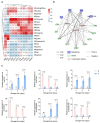Integrated Transcriptome and Metabolome Analysis Reveals Mechanism of Flavonoid Synthesis During Low-Temperature Storage of Sweet Corn Kernels
- PMID: 39766968
- PMCID: PMC11727310
- DOI: 10.3390/foods13244025
Integrated Transcriptome and Metabolome Analysis Reveals Mechanism of Flavonoid Synthesis During Low-Temperature Storage of Sweet Corn Kernels
Abstract
Sweet corn is a globally important food source and vegetable renowned for its rich nutritional content. However, post-harvest quality deterioration remains a significant challenge due to sweet corn's high sensitivity to environmental factors. Currently, low-temperature storage is the primary method for preserving sweet corn; however, the molecular mechanisms involved in this process remain unclear. In this study, kernels stored at different temperatures (28 °C and 4 °C) for 1, 3, and 5 days after harvest were collected for physiological and transcriptomic analysis. Low temperature storage significantly improved the PPO and SOD activity in sweet corn kernels compared to storage at a normal temperature. A total of 1993 common differentially expressed genes (DEGs) were identified in kernels stored at low temperatures across all three time points. Integrated analysis of transcriptomic and previous metabolomic data revealed that low temperature storage significantly affected flavonoid biosynthesis. Furthermore, 11 genes involved in flavonoid biosynthesis exhibited differential expression across the three storage periods, including CHI, HCT, ANS, F3'H, F3'5'H, FLS, and NOMT, with Eriodictyol, Myricetin, and Hesperetin-7-O-glucoside among the key flavonoids. Correlation analysis revealed three AP2/ERF-ERF transcription factors (EREB14, EREB182, and EREB200) as potential regulators of flavonoid biosynthesis during low temperature treatment. These results enhance our understanding of the mechanisms of flavonoid synthesis in sweet corn kernels during low-temperature storage.
Keywords: flavonoid synthesis; integrated analysis; low-temperature storage; sweet corn; transcriptome.
Conflict of interest statement
The authors declare no conflicts of interest.
Figures






Similar articles
-
Impact of low temperature on the chemical profile of sweet corn kernels during post-harvest storage.Food Chem. 2024 Jan 15;431:137079. doi: 10.1016/j.foodchem.2023.137079. Epub 2023 Aug 3. Food Chem. 2024. PMID: 37573745
-
Metabolomics and transcriptomics provide insights into the flavonoid biosynthesis pathway in the roots of developing Aster tataricus.J Plant Res. 2023 Jan;136(1):139-156. doi: 10.1007/s10265-022-01426-4. Epub 2022 Dec 15. J Plant Res. 2023. PMID: 36520245 Free PMC article.
-
Integrative analysis of transcriptome and metabolome reveals flavonoid biosynthesis regulation in Rhododendron pulchrum petals.BMC Plant Biol. 2022 Aug 16;22(1):401. doi: 10.1186/s12870-022-03762-y. BMC Plant Biol. 2022. PMID: 35974307 Free PMC article.
-
A Comparison of the Flavonoid Biosynthesis Mechanisms of Dendrobium Species by Analyzing the Transcriptome and Metabolome.Int J Mol Sci. 2022 Oct 9;23(19):11980. doi: 10.3390/ijms231911980. Int J Mol Sci. 2022. PMID: 36233278 Free PMC article.
-
Transcriptome sequencing and flavonoid metabolism analysis in the leaves of three different cultivars of Acer truncatum.Plant Physiol Biochem. 2022 Jan 15;171:1-13. doi: 10.1016/j.plaphy.2021.12.027. Epub 2021 Dec 26. Plant Physiol Biochem. 2022. PMID: 34968987
References
-
- Hu Y., Colantonio V., Muller B.S.F., Leach K.A., Nanni A., Finegan C., Wang B., Baseggio M., Newton C.J., Juhl E.M., et al. Genome assembly and population genomic analysis provide insights into the evolution of modern sweet corn. Nat. Commun. 2021;12:1227. doi: 10.1038/s41467-021-21380-4. - DOI - PMC - PubMed
-
- Jan B., Anwar Bhat M., Bhat T.A., Yaqoob M., Nazir A., Ashraf Bhat M., Mir A.H., Wani F.J., Kumar Singh J., Kumar R., et al. Evaluation of seedling age and nutrient sources on phenology, yield and agrometeorological indices for sweet corn (Zea mays saccharata L.) Saudi J. Biol. Sci. 2022;29:735–742. doi: 10.1016/j.sjbs.2021.10.010. - DOI - PMC - PubMed
Grants and funding
- 2023YFD1201105/National Key Research and Development Program
- 23ZYCGSN00880/Tianjin Science and Technology Assistance project
- KLIBMC2304/Tianjin Key Laboratory of Intelligent Breeding of Major Crops
- CARS-02-85/China Agriculture Research System
- No. 102/provincial rural revitalization strategy special project of Guangdong in 2024
LinkOut - more resources
Full Text Sources
Research Materials
Miscellaneous

